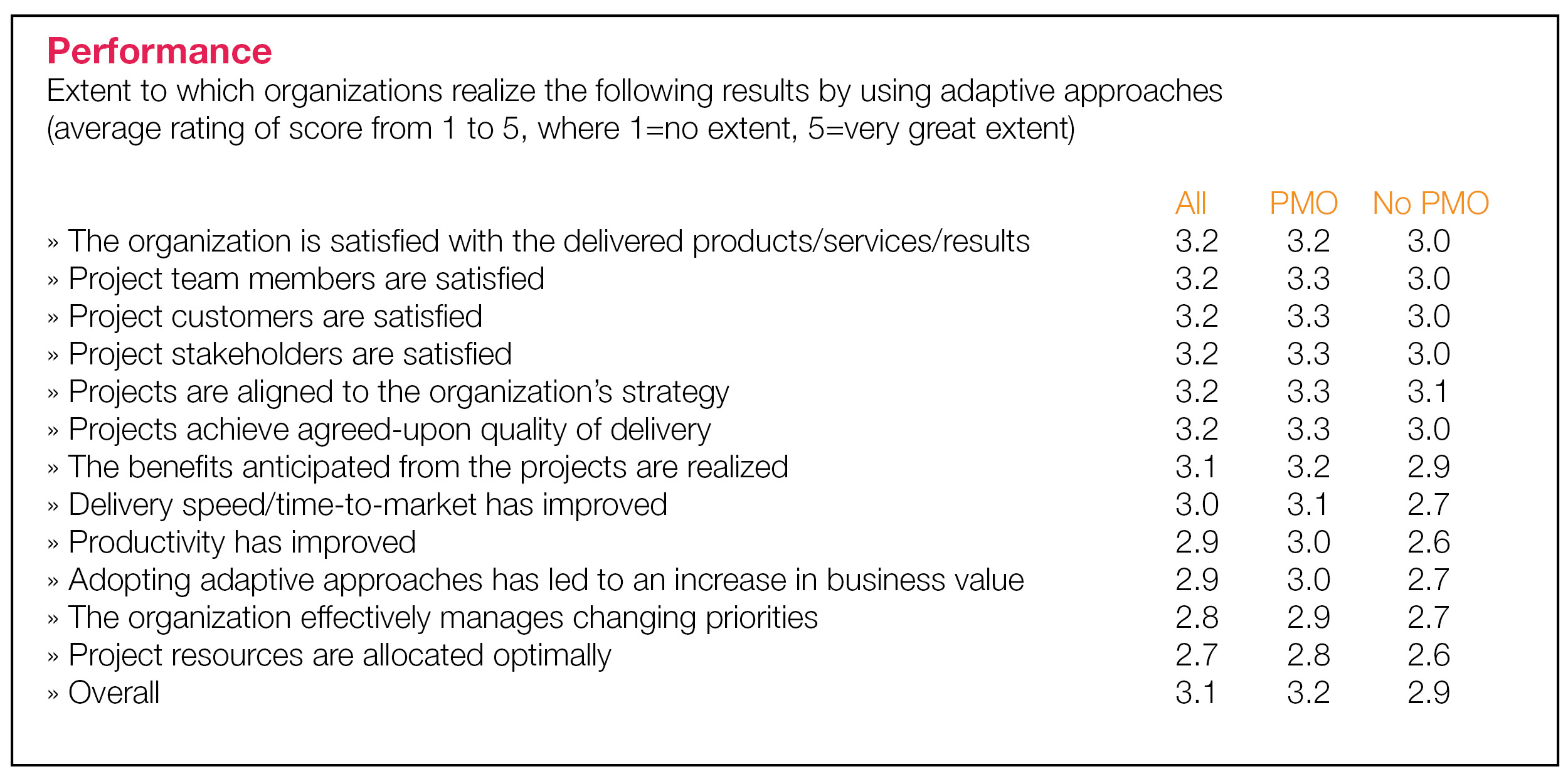One Last Question: What About the Agile PMO?
Putting a PMO in charge of agility boosts organizational performance significantly
(If you are wondering what happened to Part 2 of this series, check out Deborah Bigelow Crawford's responses to questions about training and coaching on the PM College blog here.)
I've saved the best for last. One of our webinar attendees asked:
Question: Please review more of the roles and responsibilities of the Agile PMO.
Volumes can, and have, been written in the last few years about the ways that Agile and the PMO can be integrated. As with most questions surrounding the PMO, there are two sides to this:
1. How can the PMO support the use of agile and adaptive methods on projects and programs?
2. How can the PMO apply agile methods to its own management and decision-making?
It's important to define your terms, because when people talk about the "Agile PMO" they frequently focus on only one side of this question. And this is what we did in the Adaptive Organization research study. Our data tells us not only what percentage of organizations put the PMO in charge of projects using hybrid or adaptive methods (65% ... or 76% of High Performers) but whether doing so yielded performance benefits for the company (the answer is yes: see table below!).
Here's what we do know: the High-Performing companies in the study were more likely to entrust adaptive and hybrid projects to their PMO. And that PMO played a wider variety of roles in helping adaptive projects to succeed:
High Performing Organizations are more likely to have a PMO that:
- Chooses which project management approach (predictive, adaptive, or hybrid) is most appropriate for delivering the product, service, or result
- Advises management about the business value of projects that use adaptive approaches
- Strives to deliver what’s needed and keeps a pulse on customers
- Operates as if it were a consulting business, tailoring its efforts to meet specific needs
- Provides adaptive tools and templates
- Coordinates adaptive training courses, coaches, or mentors
- Coordinates communication between teams that use adaptive approaches
- Facilitates organizational learning in adaptive approaches
- Develops guidelines for recruiting, evaluating, and selecting team leaders
- Develops and implements standards for using adaptive approaches.
Finally, some thoughts about the differences between companies with and without PMOs, as shown in our table below. A difference of .1 to .4 points might not seem that significant at first glance, but you have to remember that survey-takers are scoring their performance in whole numbers, on a 5-point Likert scale. The decimals only appear when you average all the scores. So, for each point or two above 3, we had to have quite a few companies who scored themselves 4 or 5.
To look at it another way, think about it as being similar to scoring in a maturity model. If you rebaselined your maturity score, and found you had moved 40% of the way towards the next level (from Level 3 to Level 3.4), you'd be ecstatic. And that is the impact we are seeing for many of the performance measures in the study, just for putting the PMO in charge of the culture shift to adaptive approaches.
Here's the data:

- Understanding PMaaS-Part 2
- PMaaS and Organizational Performance, Then and Now
- (More) Changing Approaches to Project Management
- What We Mean When We Say PM as a Service
- Jazzed Up About Project Management and AI
- Live from Atlanta ... People, Ideas and More, Part 2
- Live from Atlanta ... People, Ideas and More
- Value Delivery Skills Webinar Attendees Had Questions: Here Are Some Answers
- Webinar Alert: Project Management Skills for Value Delivery Research Overview
- Seven Actions for the Adaptive Organization
- PMO Staff vs PMO Leaders: Realism or Pessimism?
- High Performers Value These Skills
- PM Skills Benchmark Study: Your Second Chance to Participate
- New Research Launch: Project Management Skills for Value Delivery
- Managing Projects…Or Delivering Value? Eric Foss’s Challenge to Project Managers
- A Look Forward, With Hope and Confidence
- Some Thoughts About Governance, PMOs and the Thinking Project Manager
- PMO of the Year Finalist Ontario Power Generation
- The Future is Already Here for These PMOs
- State of the PMO Research Webinar – Your Questions, Answered: Part 2
- State of the PMO Research Webinar – Your Questions, Answered: Part 1
- Will A.I. Kill the PMO? Part 3 in Our A.I. in PM Series
- PMO Research Reveal: What You'll Learn in This Week's Webinar
- The Evolution of the Enterprise PMO: What Comes Next?
- Think Your Business Is Too Small for a PMO? Think Again.
- The Enterprise PMO Delivers
- PMOs: New Research Shows Benefits Outweigh Cost
- The PMO at 20: New Research Findings Released
- Extended: The State of the PMO Research Study, Thru Feb. 18.
- Why Research Is Important
Related Posts:
Tags:
(No ratings yet)
Popular Posts
- The Project Management Maturity Model … Now with Agile/Adaptive Assessment!
- PM Solutions Celebrates 25 Years of Project Management Excellence
- Managing Project Managers Within and Outside the PMO
Popular Categories
- Agile or Adaptive PM (5)
- Culture & Change Management (75)
- Project & Program Management (82)
- Portfolio Management (50)
- Project Management Office (PMO) (107)
- Project Management Research (50)
- Resource Optimization (26)
search blog:
Sign up for PM Solutions'
Insights eNewsletter
Delivered every other month in addition to periodic research, white papers, and news alerts.





No comments yet. Be the first one!